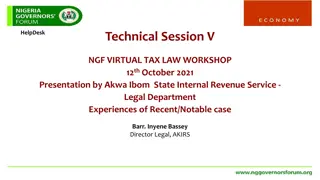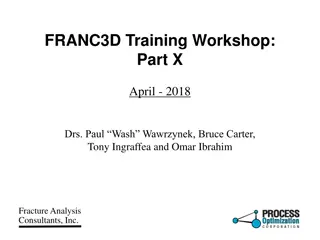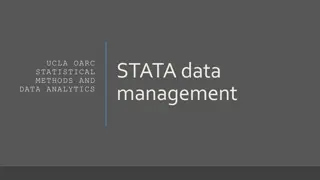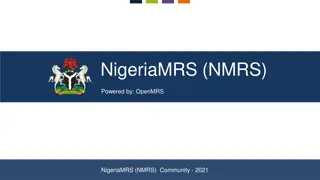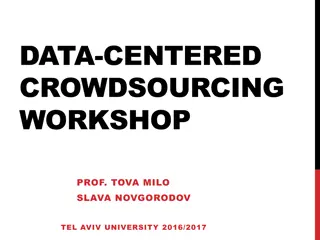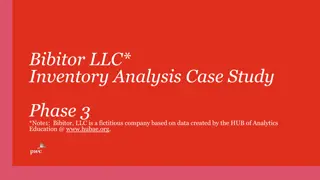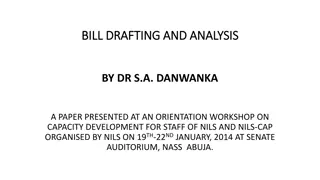Workshop on Data Analysis in Business and Law at University of Nigeria, Nsukka
This workshop at the University of Nigeria, Nsukka focuses on data analysis in business and law, covering topics such as measurement, scaling, data preparation, analysis, and interpretation. Participants will learn about the importance of data integrity, statistical tools, and the benefits of ICT in research. The workshop aims to enhance understanding of exploratory and descriptive data analyses, inferential data analysis, and ensure accurate research findings.
Download Presentation

Please find below an Image/Link to download the presentation.
The content on the website is provided AS IS for your information and personal use only. It may not be sold, licensed, or shared on other websites without obtaining consent from the author. Download presentation by click this link. If you encounter any issues during the download, it is possible that the publisher has removed the file from their server.
E N D
Presentation Transcript
UNIVERSITY OF NIGERIA, NSUKKA SCHOOL OF POSTGRADUATE STUDIES ICT/DATA ANALYSES IN BUSINESS AND LAW Resource Person PROF. GEREALDINE UGWUONAH DEPT. OF MARKETING Geraldine.ugwuonah@unn.edu.ng Phone:08033491228
OUTLINE This paper is divided into three parts namely: Introduction Measurement and Scaling Data preparation Data Analysis and Interpretation
GOALS AND OBJECTIVES At the end of this Workshop, you should learn about: Dynamics of Measurement and Scaling Types of Variables Procedures for Data Analysis Interpretation of Results
1. INTRODUCTION Information and communication technology (ICT) has contributed immensely to social and economic research. ICT incorporates electronic technologies and techniques used to manage information and knowledge, including information- handling tools used to produce, store, process, distribute and exchange information. Benefits of ICT in research can be achieved through access to online resources like e-journal, online survey, digital data capture, data sharing, storage, data analysis and report production. For the purpose of this workshop, we shall be concentrating on data analysis.
Data Analysis is the process of systematically applying statistical and/or logical techniques to describe and illustrate, condense and recap, and evaluate data. There are two major types ; Exploratory and descriptive data analyses and Inferential data analysis. Exploratory data analysis explores the data by inspecting the distribution of each variable. Descriptive statistics are used to describe the basic features of the data in a study and can be in form of table, charts and cross tabulation. Inferential data analysis provides a way of drawing inductive inferences from data and distinguishing the signal (the phenomenon of interest) from the noise (statistical fluctuations) present in the data Shamoo and Resnik (2003).
2. It is important to ensure data integrity and accuracy as well as use of appropriate statistical tool before carrying out data analysis. A violation of data integrity rule and improper statistical analyses distort scientific findings, mislead casual readers (Shepard, 2002), and may negatively influence the public perception of research. Integrity issues are just as relevant to analysis of non-statistical data as well.
Nominal scale: A nominal scale is the simplest type of scale. The numbers or letters assigned to objects serve as labels. Mention some examples of nominal scale. An ordinal scale: An ordinal scale arranges objects in an ordered relationship. Most ordinal scales are obtained through ranking. Ordinal scales answers the question of whether objects possess more or less of what is being. Give four examples.
Interval scales In interval scales, the numbers obtained represent equal increment of the attribute being measured. They also measure the order or distance in units of equal intervals. The location of the zero point in interval scale is arbitrary. Examples include temperature in degree Fahrenheit.
Ratio Scale Ratio scales have absolute rather than relative quantities. The absolute zero represents a point on the scale where there is an absence of the given attribute. Examples include, age, money and weights. Interval and ratio scale are desirable because virtually the entire range of all statistical analysis can be performed on them.
Types of scales and their properties Types Measurement Scale of Typical Application Statistics/Statistical Tests Nominal Classification (by sex, geographic area, social class) Rankings (preference, class standing) Percentages, mode/chi-square Ordinal order or rank Percentile, medium rank-order Friedman ANOVA Interval Index temperature attitude measures number, scales, Mean, standard deviation, product moment correlations,/t-test, ANOVA, regression, factor analysis. Ratio Scales, incomes, units produced, cost, age. Geometric and harmonic mean, coefficient of variation. Mean, standard deviation, product moment correlations,/t-test, ANOVA, regression factor analysis.
Data Preparation Data preparation is concerned with the following four major activities: Data editing Data cleaning Data coding Data adjustment and replacement of missing data
Data editing Helps to locate : Inconsistent or out of range responses. Omissions: When respondents intentionally or unintentionally fail to answer some questions. Ambiguity: When it is unclear as to which option the respondent chose. Lack of Cooperation: When respondents refuse to follow the instruction and ticks arbitrarily. Ineligible respondents: When a respondent who is not qualified to be in the sample is found in it.
Data coding: Translates responses into values suitable for computer entry and statistical analysis. Number 1 Do you eat indomie Question Question Description Range of Permissible Values 0 = no, 1 = yes, 9 = blank 0 = husband, 1 =Myself, 2 = father, 3 = mother, 4 = relative, 5 = friend, 6 = other, 9 = blank. 1= supermarket, 2=open market, 9=blank 0 = less than 1 month, 1 = three months, 2 = six months, 3 = year, 4 = other, 9=blank 2 Who is buys it for you? 3 Where do you buy it? 4 How often do you buy indomie? 5=to a very large extent, 4= to a large extent, 3=to a fair extent, 2=to a low extent, 1=to a very large extent, 9=blank 5To what extent are satisfied with the flavour of indomie?
Data cleaning Once the data have been keyed in the data, they are to be subjected to a series of computer checks to clean them. Checks can be obtained through single table or cross table frequency distribution. Two major checks should be carried out. (a)Range checks (b)Consistency checks
Data Analysis There are two major aspects of data analysis, namely: Descriptive and Inferential data analysis.
Descriptive Data Analysis Provide simple summaries about the sample Examples are: count, mean, median, mode and measures of dispersion like variance and standard deviation. Descriptive statistics may present data in tables, cross tabulations and/or graphs
Common Inferential Statistics Chi-square t-test Analysis of variance (ANOVA) Correlation analysis Regression analysis Discriminant analysis Factor analysis
Demonstration of Statistical Analysis We shall use the remaining time to demonstrate how to analyse data using SPSS.
WHAT I HAVE LEARNT FROM THE WORKSHOP Want to share?
Summary/Recommendations/Conclusion In the course of this module, we have gone through measurement and scaling, data editing and analysis of data using descriptive and inferential statistics. This presentation gives the participant an idea of what data analysis is all about and how data can be analysed Thank You!
























